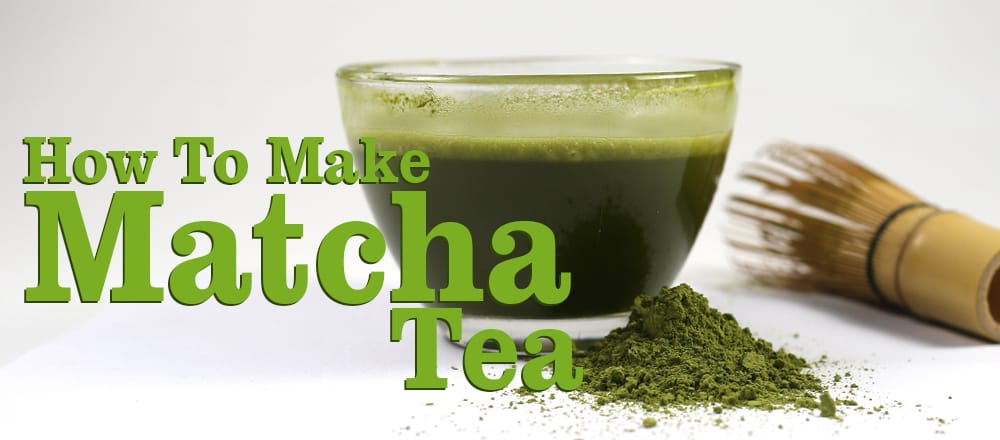How To Make Matcha Tea

Matcha Tea has become immensely popular in recent years. This is in part because of its extraordinary taste and in part because of its well publicised benefits. Indeed, casual Tea drinkers and connoisseurs alike flock to this beverage, but how do you make Matcha Tea?
In this article, we will talk about what makes this delectable infusion so unique. Then, we will show you exactly how to make Matcha Tea. Best of all, you can buy it here at our Kent-based factory, where we pack our Loose Teas, Tisanes and Coffees fresh to order.

What is Matcha Tea?
Matcha is Tea in powdered form. The type of Tea can vary, although most associate it with Green Tea. The Camellia sinensis (Tea) plant used in its making is for two weeks shade-grown before harvesting. This allows the leaves to produce larger quantities of amino acids and chlorophyll.
But what makes these chemical compounds so special? Amino acids and chlorophyll can work as antioxidants. This enables them to combat free radicals in the body, which ultimately reduces the risk of developing a multitude of chronic conditions. Because of the unique processing of Matcha, it reportedly contains 137 times more antioxidants than ‘standard’ Green Tea.
Health-conscious individuals often choose Matcha. Why? Matcha Tea Benefits, of course. According to the latest scientific research, it can promote weight loss, enhance cognitive function, boost the immune system and improve cardiovascular health. Most, however, drink this beverage because, put simply, it tastes great. When brewed, it has a rich, astringent flavour with refined grassy notes.

Other Matcha Facts
- Unlike other Green Tea types, Matcha uses the whole leaf.
- White Tea is a popular choice for making Matcha. This, of course, includes our very own White Kenya Matcha Tea.
- Contrary to popular belief, Matcha originated from China, not Japan.
- Despite coming from China, it has long had a close association with the Japanese Tea Ceremony, which dates back to the 10th Century CE.
- According to the American Journal of Clinical Nutrition, one cup of Matcha a day “might be useful in the prevention and improvement of lifestyle-related diseases, mainly obesity.”
How To Make Matcha Tea
Before you start, there are a few items that you could consider buying for making traditional Matcha. A Bamboo Tea Spoon measures out the exact amount of Tea needed, while a Matcha Tea Whisk helps to create the right consistency. Both of these items are available here at The Kent and Sussex Tea and Coffee Company.
There is, of course, the option to host a Matcha Tea Ceremony. You can find instructions for this in our blog. Those who want to enjoy this infusion without such rituals, however, can follow the instructions below:
- Add 1-2 scoops of Matcha into a cup or Matcha bowl.
- Now add hot (but not boiling! Never boiling!) water into the cup or bowl.
- Whisk the infusion using a traditional bamboo whisk until frothy.
- Consider topping up with a small amount of warm water.
Sit back, relax and enjoy – it’s as simple as that.
If you’re looking to make things a little more interesting, why not try a Matcha Tea Latte? You can use the instructions found in our Green Tea Latte Recipe article and apply them to this beverage, too. There are many other recipes worth considering, some that even use porridge, cereal and yoghurt. If that wasn’t enough, there’s the option to make cakes, ice creams and biscuits using this Tea.

Where To Buy Matcha
The Kent and Sussex Tea and Coffee Company stock several Matcha Tea varieties. Each one is delicious. Each one is unique. What more could you want from your cuppa?
The most popular choice is our traditional Matcha Powder, a great starting point into the world of this much-loved Tea type. Another option is China Organic Taishan Matcha Tea for those who prefer China Matcha over Japanese Matcha.
Alternatively, you could branch out and try our Peppermint Flavoured Matcha. This is a Flavoured Tea with strong herbaceous notes and refreshingly grassy undertones.
Whatever, you choose, you’ve chosen well with us.

 Loose Leaf Tea
Loose Leaf Tea Pyramids
Pyramids Tea Bags
Tea Bags Africa
Africa Assam
Assam Ceylon
Ceylon Chinese
Chinese Darjeeling
Darjeeling European
European Indian
Indian Japan
Japan Nepal
Nepal South East Asia
South East Asia Ayurveda Tea
Ayurveda Tea Black Tea
Black Tea Chai Tea
Chai Tea Flowering Tea
Flowering Tea Fruit Tisanes
Fruit Tisanes Green Tea
Green Tea Herbal Tea
Herbal Tea Matcha Tea
Matcha Tea Oolong Tea
Oolong Tea Organic Tea
Organic Tea Pu erh Tea
Pu erh Tea Rooibos Tea
Rooibos Tea White Tea
White Tea Asian Coffee
Asian Coffee Caribbean Coffee
Caribbean Coffee Central American Coffee
Central American Coffee South American Coffee
South American Coffee Coffee Blends
Coffee Blends Decaffeinated Coffee
Decaffeinated Coffee Espresso Coffee
Espresso Coffee Ethically Sourced Coffee
Ethically Sourced Coffee Flavoured Coffee
Flavoured Coffee Organic Coffee
Organic Coffee Single Origin Coffee
Single Origin Coffee Chocolate 1
Chocolate 1 Chocolate 2
Chocolate 2 Chocolate 3
Chocolate 3 Chocolate 4
Chocolate 4 Chocolate 5
Chocolate 5 Chocolate 6
Chocolate 6 Chocolate 7
Chocolate 7 Chocolate 8
Chocolate 8 Chocolate 9
Chocolate 9 Loose Tea Filters
Loose Tea Filters Tea Accessories
Tea Accessories Tea Bricks
Tea Bricks Tea Caddies
Tea Caddies Tea Caddy Spoons
Tea Caddy Spoons Tea Gift Ideas
Tea Gift Ideas Tea Infusers
Tea Infusers Tea Strainers
Tea Strainers
